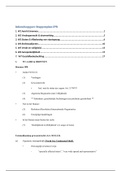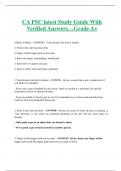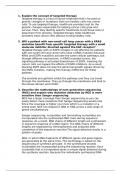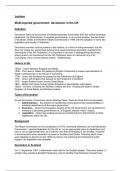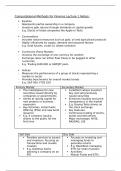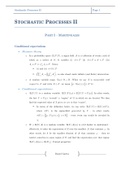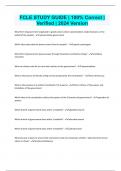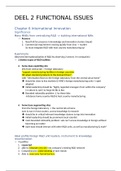Lecture 1.1 de Lange, Taris, Kompier, Houtman & Bongers (2003)
Demand-control model:
Demands: workload, working tempo, being available, mentally
investng work
Control: freedom to organize own work
Strain-hypothesis: low control & high demands -> stress.
Control bufers the efect of demands on stress
Demand-control-support model: collectve or isolated
Iso-strain-hypothesis: low control & high demands &low support = iso-strain jobs -> stress
Limitatons of reviews on strain hypothesis:
Didn’t take methodological quality in account -> biased
Cross-sectonal studies
o Doesn’t tell us anything about causality
o Might be reversed and reciprocal (alternatve explanaton for efect)
Didn’t state what results confrm the hypothesis
Goal artcle:
Defniton of support of the strain hypothesis
o Both additve efects (hoofdefect) and/or multplicatve efects (interacte-efect)
Examining high-quality longitudinal research (advantage: high quality and no other infuences
on the relatonship, disadvantage: no diference in efect between low and high quality
studies, choice of criteria is hard.
o Type of design: complete panel design
Statstcally signifcant associaton between and YX
Causal variable precedes the efect variable YX – causality
Standard causal relatonship
Reversed causal relatonship
Reciprocal causal relatonship
The associaton between and YX is not due to third variables
There is a plausible theoretcal argument for the relatonship
o Length of tme lags: consideratons regarding the tme length should be
complemented with plausible theoretcal and methodological arguments
o Quality of measures. Reliability: good references, includes an objectve measure and
own data
o Method of analysis: multple regression analysis and structural equaton modeling
o Nonresponse analysis: exploring associaton between work and health at baseline for
the response group versus the group that drops out afer baseline.
Evidence for standard, reversed and reciprocal causal relatonships
Limitatons:
Evaluaton criteria not always applicable for every outcome variable
Possible other criteria
, Low quality studies under or overestmaton of the efect (diferent bias)
Some studies based on partly same dataset
Recommendatons for future research:
1. More research on specifc (and objectve outcomes) – no self-report
2. More research on the efects of stable and changing DC/S dimensions over tme (short versus
long term).
3. More research on the impact of diferent tme lags
4. More research using diferent cutof points
5. More research on reversed and reciprocal causaton
6. More discussion concerning the impact of various confounders
7. More research examining the actvaton hypothesis
Demand-control model:
Demands: workload, working tempo, being available, mentally
investng work
Control: freedom to organize own work
Strain-hypothesis: low control & high demands -> stress.
Control bufers the efect of demands on stress
Demand-control-support model: collectve or isolated
Iso-strain-hypothesis: low control & high demands &low support = iso-strain jobs -> stress
Limitatons of reviews on strain hypothesis:
Didn’t take methodological quality in account -> biased
Cross-sectonal studies
o Doesn’t tell us anything about causality
o Might be reversed and reciprocal (alternatve explanaton for efect)
Didn’t state what results confrm the hypothesis
Goal artcle:
Defniton of support of the strain hypothesis
o Both additve efects (hoofdefect) and/or multplicatve efects (interacte-efect)
Examining high-quality longitudinal research (advantage: high quality and no other infuences
on the relatonship, disadvantage: no diference in efect between low and high quality
studies, choice of criteria is hard.
o Type of design: complete panel design
Statstcally signifcant associaton between and YX
Causal variable precedes the efect variable YX – causality
Standard causal relatonship
Reversed causal relatonship
Reciprocal causal relatonship
The associaton between and YX is not due to third variables
There is a plausible theoretcal argument for the relatonship
o Length of tme lags: consideratons regarding the tme length should be
complemented with plausible theoretcal and methodological arguments
o Quality of measures. Reliability: good references, includes an objectve measure and
own data
o Method of analysis: multple regression analysis and structural equaton modeling
o Nonresponse analysis: exploring associaton between work and health at baseline for
the response group versus the group that drops out afer baseline.
Evidence for standard, reversed and reciprocal causal relatonships
Limitatons:
Evaluaton criteria not always applicable for every outcome variable
Possible other criteria
, Low quality studies under or overestmaton of the efect (diferent bias)
Some studies based on partly same dataset
Recommendatons for future research:
1. More research on specifc (and objectve outcomes) – no self-report
2. More research on the efects of stable and changing DC/S dimensions over tme (short versus
long term).
3. More research on the impact of diferent tme lags
4. More research using diferent cutof points
5. More research on reversed and reciprocal causaton
6. More discussion concerning the impact of various confounders
7. More research examining the actvaton hypothesis

